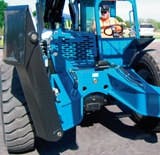(Above) Ingersoll Rand's unique frame-mounted stabilizers aren't designed to support the entire weight of the machine and load, but they allow frame-sway to function when they're deployed.
Tables: |
|
|
At the Telehandler Showcase, each machine was equipped with outriggers — or stabilizers, in the case of Ingersoll Rand — to attain their load capacities at maximum height and outreach. Some units have interlocks to limit machine operation without deploying the outriggers (see the telehandler-features spreadsheet below). The reach charts for these respective machines vary greatly, so buyers and users should look closely at the charts when buying, renting, or operating these machines.
As with engine location (read more in the story on page 9), there is a clear line of differentiation when it comes to how the outriggers are mounted. They are either mounted to the frame or the front axle. The spreadsheet below identifies the differing designs for each model. Also similar to the engine location, it is no surprise there are two differing opinions about which mounting system works best.
The inset image shows the frame-mounted design. Notice on the Gradall that the supports are clearly part of the chassis. Once the outriggers are set in place, the operator must either use the outrigger itself to level the frame or raise both outriggers, re-level, and reset.
Axle-mounted outriggers are directly linked to the machine axle, which moves independently of the frame. This allows frame-leveling when the outriggers are already in place, so the stance does not have to change. By comparison, frame-sway is not possible with frame-mounted outriggers.
Those that market machines with frame-mounted outriggers would argue that once the outriggers are set and the unit is properly leveled, swaying the chassis is not necessary once the load is in the air. These manufacturers also like to point out that they believe frame-mounted outriggers can be mounted higher, which improves the approach angles.
There is one exception to both configurations. Ingersoll Rand does not use outriggers, but instead, it has stabilizers. Unlike outriggers, stabilizers are not intended to support the weight of the machine or the load, and they only come into play if the machine was to laterally lean on them on one side or the other. As shown in image (top, right), the stabilizers are frame-mounted but are designed to allow frame-sway up to 40 percent of the normal operating range.
Showcase Machine Features |
|
Introduced |
Outrigger mounting |
Engine location |
Rollers or slide pads in boom |
Telescopic (crowd) cylinder location |
Standard tire fill |
Rear axle stabilization (RAS)* |
Warranty |
| * Sway = Frame-Leveling |
| ** B-to-B = Bumper to Bumper |
| ** OR = Outriggers |
| Gehl DL-10H/55 |
1998 |
Frame-Mounted |
Side-Mounted |
Slide Pads |
External Below Boom |
Pneumatic |
Above 60°. Set park brake and shift to neutral, axle locks and sway speed is dampened. |
B-to-B: 1 year; Drivetrain: 2 years or 2,000 hours; Frame Structure: 10 years |
| Genie GTH-1056 |
2000 |
Axle-Mount |
Rear (In-Frame) |
Rollers |
External Below Boom |
Calcium Chloride |
Above 55°. Disengage transmission and lock-out axle. |
B-to-B: 1 year; Hydraulic: 3 years; All structural: 5 years |
| Gradall 544D 10-55 |
1997 |
Frame-Mounted |
Mid-Mounted (In-Frame) |
Slide Pads |
External Below Boom |
Calcium Chloride |
Dampened speed when above 45°. |
B-to-B: 1 year; Drivetrain: 2 years; Structure including boom: 5 years |
| Ingersoll Rand VR1056C |
2001 |
Frame-Mounted "Stabilizers" |
Mid-Mounted (In-Frame) |
Slide Pads |
Internal |
Pneumatic |
E-Z Lock system. Above 40° sway is dampened, 6° max. Axle locks with brake activation. |
B-to-B: 1,000 hours; Engine: 2,000 hours (optional 3,000-hour extended engine warranty) |
| JLG G10-55A |
2004 |
Frame-Mounted |
Side-Mounted |
Slide Pads |
External Below Boom |
Pneumatic |
None |
B-to-B: 1 year; Drivetrain: 2 years; Structure including boom: 5 years |
| Lull 1044C-54 Series II |
2005 |
Axle-mounted |
Rear (In-Frame) |
Slide Pads |
Under Boom |
Calcium Chloride |
Between 20° and 40°. Limited to operation in 1st and 2nd gear. |
B-to-B: 1 year; Drivetrain: 2 years; Structure including boom: 5 years |
| Manitou MT-1745 HSL Turbo |
2003 |
Frame-Mounted |
Side-Mounted |
Slide Pads |
External Below Boom |
Pneumatic |
Axle locks when boom above 60°. |
1 year or 2,000 hours. Extended warranties available. |
| Mustang 1155 |
|
Frame-Mounted |
Side-Mounted |
Slide Pads |
External Above boom |
Pneumatic |
Above 60°. Set park brake and shift to neutral, axle locks and sway speed is dampened |
B-to-B: 1 year; Drivetrain: 2 years or 2,000 hours; Frame Structure: 10 years |
| Pettibone Extendo 10056 |
2001 |
Axle-Mounted |
Mid-Mounted (In-Frame) |
Slide Pads |
External Below Boom |
Pneumatic |
Axle locks with parking brake activation. Dampened pivot above 25°. |
2 years or 2,000 hours |
| SkyTrak 10054 |
2000 |
Axle-Mounted |
Rear (In-Frame) |
Slide Pads |
External Below Boom |
Pneumatic |
Stabil-Trak Above 40°. Shift to neutral and set brake, axle locks and pivot is dampened |
B-to-B: 1 year; Drivetrain: 2 years; Structure including boom: 5 years |
| Xtreme XRM1254 |
2006 |
Axle-Mounted |
Mid-Mounted (In-Frame) |
Rollers |
Internal |
Foam-Filled |
Above 40° sway is dampened when in gear or brake released. Override allows sway in neutral or with service or park brake applied |
Chassis: 10 years; Boom and Rollers: 5 years; Hydraulics: 3 years; Drivetrain: 2 years |
| ZoomBoom 10056 |
2003 |
Axle-Mounted |
Mid-Mounted (In-Frame) |
Slide Pads |
External Below Boom |
Pneumatic |
Above 45°. Put in neutral, activate brake, and axle locks. Also has dampened pivot mode. |
B-to-B: 1 year; Hydraulic: 3 years; All structural: 5 years; Engine: 2 years or 2,000 hours |





